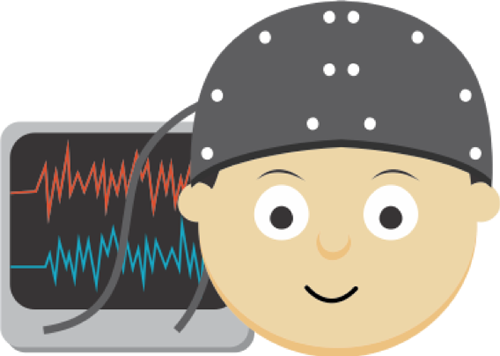Are you interested in having your child participate in one of our studies? Please email us at: devneurolab@utdallas.edu.
To Participate
Address:
Callier Center for Communication Disorders
1966 Inwood Rd. A118
Dallas, TX 75235
Email:
devneurolab@utdallas.edu
Phone:
(972) 883-3164
Who can participate?
We are currently recruiting children between the ages of 9 to 12 for an EEG word learning studies.

If your child is:
- Between the ages of 9 to 12 years old.
- Qualifies for free or reduced lunch (please contact us if you are not sure)
- Right-Handed
- Fluently speaks English.
- Has normal hearing.
- No history of developmental or neurological disorders
Why participate?
Being involved in research can be fun, educational, and rewarding!
- Children interested in science can see what a real neuroscience lab looks like while learning about the brain
- Participants choosing compensation for this study earn a $75 gift card
- They will even receive an EEG picture of their brain’s activity from the session to take home!
What is involved?
This study occurs over a few sessions. For session 1, your child will be given a series of assessments, and you will be asked to complete some forms pertaining to your child’s language and neurological history, demographic information, and information on your child’s home environment.
Session 2 will include the EEG task. A cap of sensors will be placed on your child’s head to record the neurological activity accompanying the task. The EEG cap is tight like a tight swimming cap. The sensor cap will be placed on your child’s head and then a small amount of water and salt mixture will be added to each sensor from the outside of the cap.
This trip to the lab includes two parts, one in which we study how children’s brains process language using a special cap called an EEG cap and one where we just ask questions to assess general abilities that are often related to word learning, like reading and vocabulary.
In the EEG session the child will wear a soft cap while reading sentences and answering questions about those sentences. The EEG studies that we conduct are completely non-invasive and non-harmful. We use a new type of cap that contain sponges held in place by a loose-fitting nylon material; when moistened, these sponges are able to record brain activity. The only side-effect of the study is a somewhat messy head of hair.
During the question session, the child will not need to wear the cap. They will be asked to do some simple tasks like repeating made up words and answering questions about pictures they view or paragraphs they read.
After the study children will receive a print-out of their EEG recording to take home along with a gift card. All of our studies undergo rigorous approval and oversight by the Internal Review Board of the University of Texas at Dallas. After-school and weekend timeslots are available year-round.
After-school and weekend timeslots are available year-round!
What is the purpose of this study?
The goal of our current study is to gain a better understanding of how children learn words from context and how that changes as they develop. We believe that very young children learn new words through fast mapping. Fast mapping refers to the ability to correctly attach a label to an object in the environment with only a single exposure to the word. But what happens as we get a little older and start to learn words for things that are not physical objects or things that we can see?
Think of words like: dream, wish, or ideals. Since you can’t point to an object to show what these words are, we need a different way to learn what they mean. One of the ways we do this is through learning from context. When we learn through context we use the words we know in a sentence to try to figure out what a new word may mean. This is something school age children do every day, but we don’t have much information about what is happening in their brain while they are learning.
What happens after the study?
The EEG data obtained from all participants will be added together and analyzed as a group, so information from specific individuals is not identifiable. Following analysis, we typically present our results at a professional conference and then to a scientific journal for publication. Parents interested in reading the eventual publications can follow us on Facebook for updates.
For more information, contact us by phone at (972) 883-3164 or email us.